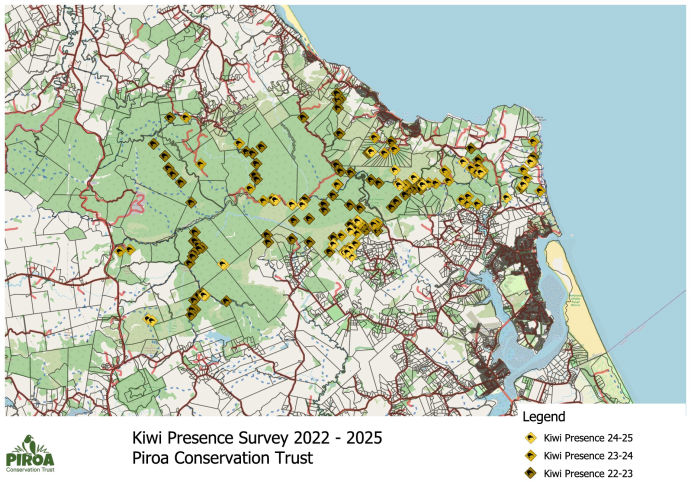KIWI SPREADING IN THE RANGES
Deb Searchfield, a former bird keeper at Auckland Zoo, now plays a key role in the conservation of the Northland brown kiwi through her work with the Piroa Conservation Trust (PCT). Deb's journey from zookeeper to kiwi conservationist began after moving to Bream Tail. Initially seeking advice from PCT on trapping on her own land, Deb quickly became part of PCT’s kiwi monitoring project.
“Working with native birds has always been a dream of mine,” Deb shared. “At Auckland Zoo, I loved working with endangered birds and native bats. When I moved here and started hearing kiwi calls on my property, I knew I had to be part of this conservation effort.”
Leading the kiwi monitoring project, Deb monitors kiwi presence across various areas using kiwi listening devices. “We place listening devices in the bush for seven nights, recording only at night. These devices pick up kiwi calls, which we then analyse using a computer program that creates visual representations of the sounds,” she explained.
“The project covers significant areas. We’ve found kiwi from SH1 in the west to Bream Tail Farm in the east and behind Langs Beach to the north,” Deb noted. “It’s impressive that they’ve crossed Cove Road to Bream Tail Farm. This tells us that they’re spreading and thriving, which is a reason for all of us to be more careful when driving at night.”
The findings from the monitoring efforts have been promising. “While we can't give exact numbers, we can confirm that kiwi presence is increasing,” Deb said. “Kiwi males call more frequently than females and travel more, their calls help us understand their movements and the impact of our conservation efforts.”
The spread of kiwi from their release site in Marunui, a property northwest of Mangawhai, to new areas of the Brynderwyns indicates the success of our community efforts. Kiwi were locally extinct in the Brynderwyns area until 2013 to 2025, when 43 North Island brown kiwi were translocated to Marunui. Subsequently, six more birds were translocated in 2020, bringing the total to 49 released birds. “Effective and intensive predator control and great habitats have contributed significantly to this success,” Deb emphasised. “Our work protects not just kiwi but other birds as well, like bittern and bellbird. Kiwi are a keystone species; looking after them means looking after many others.”
For Deb, the most rewarding part of the project has been getting to know the Brynderwyns better and witnessing the community's excitement. “People are always thrilled to hear that they have kiwi on their property,” she said. “It’s inspiring to discuss with neighbours and community predator control strategies, all in support of kiwi conservation.”
The community plays a crucial role in supporting kiwi conservation. Landowners can create safe environments for kiwi by trapping on their property or joining a community trapping project, being responsible dog owners, and being cautious during night driving. “Kiwi aren’t just in native bush,” Deb pointed out. “They could be in long grass by a pond or under pampas bush at the edge of a field.”
Despite the successes, challenges remain. “Predators, climate change, habitat destruction, and human activities are ongoing threats,” Deb warned. “But with continued community support and awareness, we can ensure the Northland brown kiwi continues to thrive.”
Deb remains hopeful for the future. “We have a unique opportunity to make a difference. Living in an area where kiwi are spreading is a privilege, and it’s our responsibility to protect them. Together, we can make a significant impact.”
If you hear kiwi calls, please get in touch with us at [email protected]. We’re always happy to check any reports, even if you’re not sure. Reach out to Piroa Conservation Trust if you’d like to join our community conservation efforts on your own property or join a trapping crew. Every action counts towards creating a haven for these incredible birds.

